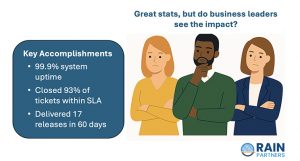3 Presentations Every Influential CIO Must Have

There’s no escaping the fact that one of your most important jobs as a CIO or senior IT leader is communication.
Whether it’s to kick off a major project, discuss strategy, brief consultants, review projects, or join a new initiative, you’re always out there being called upon to present at one meeting or another.
From what I’ve observed, many of you spend a large percentage of your “free time” (my estimates are about 35%) preparing presentations. And it’s my opinion that as important as these presentations are, you’re burning way too much time and effort getting them ready.
What’s more, you’re causing untold damage to your personal credibility and to the credibility of your department.
Here’s the typical scenario: You’re the CIO and you have to get a presentation done. What do you do? You turn to one of your lieutenant’s and you say, “I need a presentation for our upcoming IT leadership meeting (or whatever the topic may be).” Then you ask him to put together some slides for you so that you have something to say at the meeting.
When this happens, it causes multiple layers of damage. First of all, it drags your key managers away from their jobs and turns them into PowerPoint jockeys. Instead of managing their projects and people, they are sitting with you trying to quickly figure out what to say.
But it gets much worse because, let’s face it, the likelihood that they will take the time and effort to really figure out what message you should be delivering and then putting it together for you is pretty minimal. Remember, these are busy people with lots on their plates already.
So what do they do? They tap their key people and tell them to reach for whatever slides they think are relevant from other presentations. And before you know it, a few more IT professionals (now two levels removed from the presentation) are scurrying around pulling together a deck for the boss.
As the deadline comes closer, you call together the team to show them YOUR presentation. And, of course, it’s far off the mark. It’s not at all what you need. Well, no surprise there. Did you really spend the time necessary to think it through carefully and to communicate your needs?
If you’re like most busy IT leaders, you probably talked with your people for a few minutes, referenced a few slides or ideas, and told them to “just get something credible done.” Well, from their perspective it seems credible.
With presentation day fast approaching, you get into your well-trodden fire-fighting mode and you do what any smart IT leader would do in such a situation … you call your favorite fancy-talking, buzzword-ready consultant to come lend a hand. And since your consultant charges a pretty penny, you make sure to be right there with her to get maximum value from every minute.
And finally, after a hard burn and a big bill, you have a flashy presentation created by an external consultant ready in just the nick of time.
Now comes the best part. The result of your hard work and money is you treat your colleagues to, yet another boring PowerPoint presentation filled with new ideas that barely connect to the last presentation you did. Oh, and remember all your key people who dropped everything to help you with the presentation? They really appreciate seeing little to none of their work in the final product.
The net of it is that if you are honest with yourself, you’ll see that you’re likely delivering disjointed messages and positioning yourself as a momentary tactical responder not a strategic visionary and leader. Sorry to be so harsh, but I’ve seen it too many times to soft-peddle this issue.
But there’s a better way, and it’s easy. All you have to do is take your cue from what good business leaders and politicians are doing. They have a couple standard presentations with a couple key messages that they modify and combine depending on their audiences. But the core message is essentially the same and the material is nearly always the same, which means there’s no redoing slides and there’s no preparing different presentations.
That’s the general principle; now let’s put it to work in an IT context. IT leaders need a little more content than politicians so one presentation isn’t quite enough. My experience is that there are three standard presentations IT leaders need to have at the ready, they are:
The vision presentation: Presents your vision of where technology is going in your industry and how it is likely to affect your company. The strategy presentation: Spells out the IT agenda, program, and operating model. It demonstrates IT’s link to the business objectives and strategy. And it presents IT’s identity and place within the business model. The business presentation: Provides both an overview and detailed metrics of how IT resources are consumed by the business, globally and unit by unit.
Nearly every situation you are called to present at is directly related to at least one if not two of these critical topics. And if it’s not, you ought to ask yourself very serious questions about being there. By combining the right slides from these presentations, which you will learn to keep up to date, you’ll be able to cover anything that comes up.


